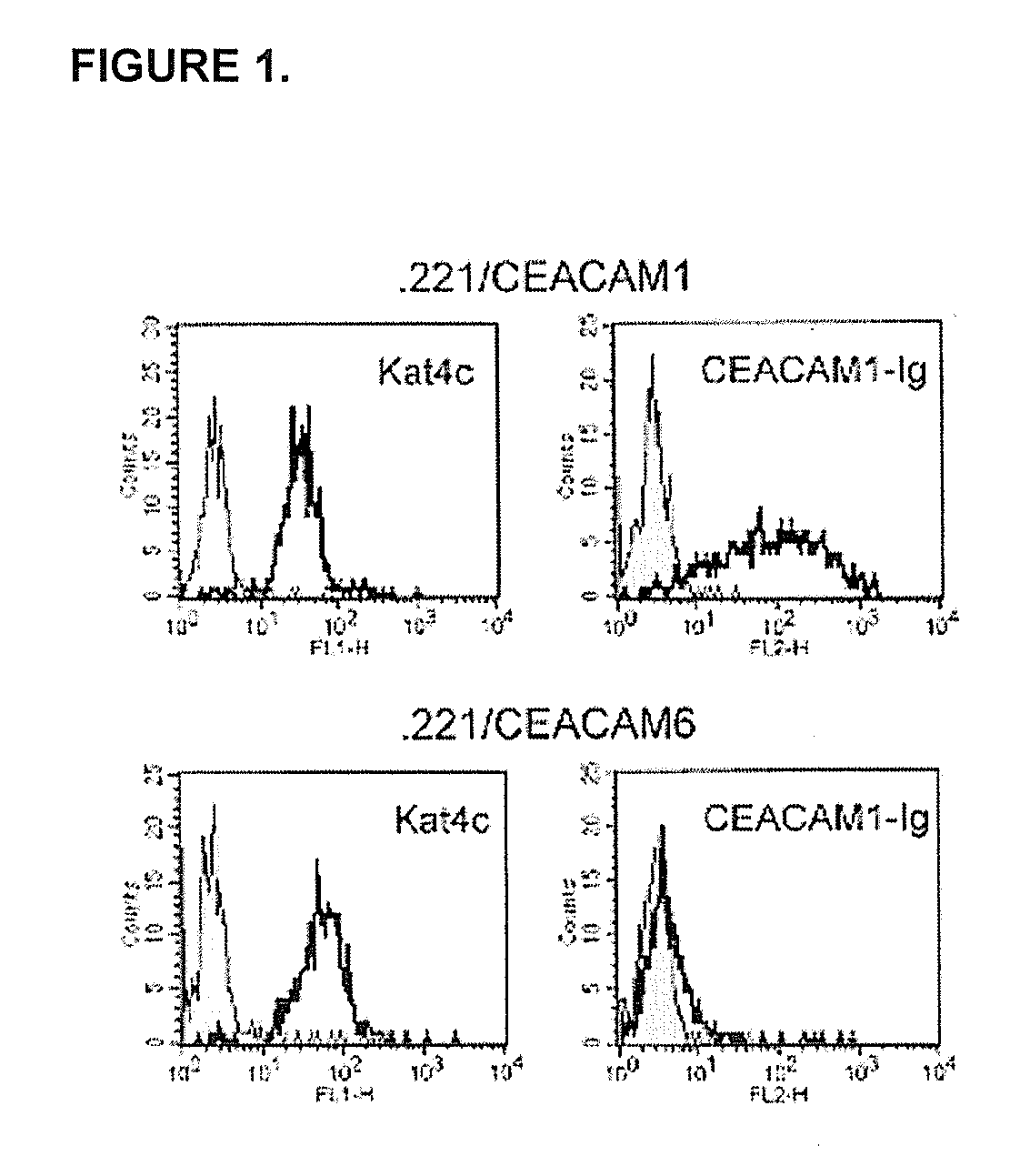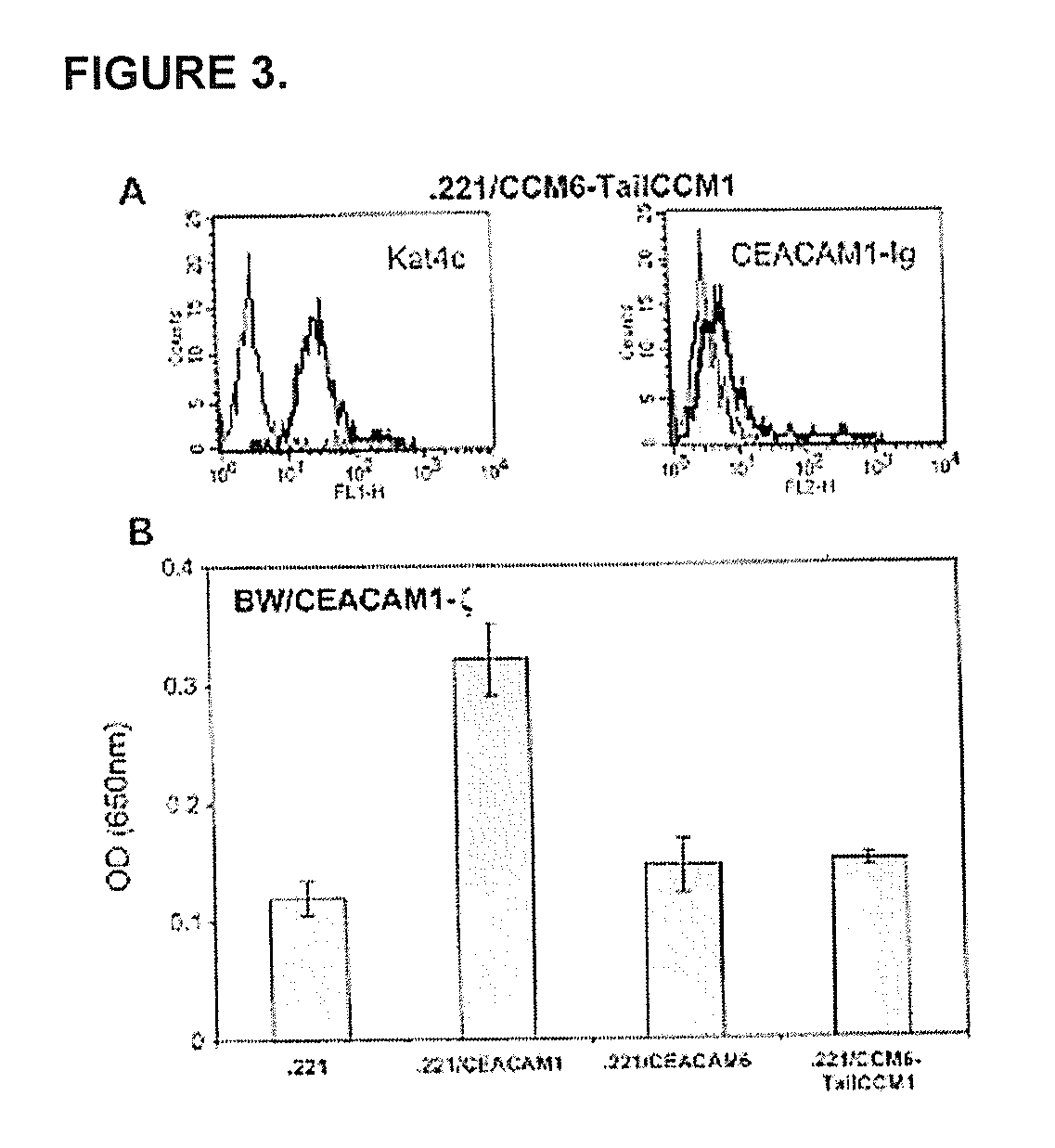Modulation of Immunity and Ceacam1 Activity
a technology of immune system and activation factor, applied in the field of immune system activation, can solve the problems of cell becoming susceptible to nk cell attack, and achieve the effect of enhancing the efficacy of tumor-infiltrating lymphocyte (til) based therapy
- Summary
- Abstract
- Description
- Claims
- Application Information
AI Technical Summary
Benefits of technology
Problems solved by technology
Method used
Image
Examples
example 1
Residues 43R and 44Q of Carcinoembryonic Antigen Cell Adhesion Molecules-1 (CEACAM1) are Critical in the Protection From Killing by Human NK Cells
[0161] The present inventors have shown that the CEACAM1 (CD66a) homophilic interactions inhibit the killing activity of NK cells. This novel inhibitory mechanism plays a key role in melanoma immune evasion, inhibition of decidual immune response, and controlling NK autoreactivity in TAP2-deficient patients. These roles are mediated mainly by homophilic interactions, which are mediated through the N-domain of the CEACAM1. The N-domain of the various members of the CEACAM family shares a high degree of similarity. The present inventors have addressed which of the CEACAM family members are able to interact with CEACAM1 and what amino acid residues control this interaction. In this section it is shown that CEACAM1 interacts with CEACAM5, but not with CEACAM6. The present inventors have demonstrated the inability of CEACAM1 to bind CEACAM6. I...
example 2
Biological Function of the Soluble CEACAM1 Protein and Implications in TAP2-Deficient Patients
[0210] Interactions of natural killer (NK) cells with MHC class I proteins provide the main inhibitory signals controlling NK killing activity. However, TAP2-deficient patients suffer from autoimmune manifestations only occasionally in later stages of life. The present inventors have demonstrated that the CEACAM1-mediated inhibitory mechanism of NK cytotoxicity plays a major role in controlling NK autoreactivity in three newly identified TAP2-deficient siblings. This novel mechanism probably compensates for the lack of MHC class I mediated inhibition. The CEACAM1 protein can also be present in a soluble form and the biological function of the soluble form of CEACAM1 with regard to NK cells was investigated by the present inventors. In this section, the present inventors will show that the homophilic CEACAM1 interactions are abrogated in the presence of soluble CEACAM1 protein in a dose-dep...
example 3
The Mechanisms Controlling NK Cell Autoreactivity in TAP2-Deficient Patients
[0231] The killing of natural killer (NK) cells is regulated by activating and inhibitory NK receptors that recognize mainly class I major histocompatibility complex (MHC) proteins. In transporter associated with antigen processing (TAP2)-deficient patients, killing of autologous cells by NK cells is therefore expected. However, none of the TAP2-deficient patients studied so far have suffered from immediate NK-mediated autoimmune manifestations. The present inventors have demonstrated the existence of a novel class I MHC-independent inhibitory mechanism of NK cell cytotoxicity mediated by the homophilic carcinoembryonic antigen-related cell adhesion molecule 1 (CEACAM1) interactions. In this section the present inventors identify 3 new siblings suffering from TAP2 deficiency. NK cells derived from these patients express unusually high levels of the various killer cell inhibitory receptors (KIRs) and the CEA...
PUM
| Property | Measurement | Unit |
|---|---|---|
| concentration | aaaaa | aaaaa |
| concentration | aaaaa | aaaaa |
| concentration | aaaaa | aaaaa |
Abstract
Description
Claims
Application Information
 Login to View More
Login to View More - R&D
- Intellectual Property
- Life Sciences
- Materials
- Tech Scout
- Unparalleled Data Quality
- Higher Quality Content
- 60% Fewer Hallucinations
Browse by: Latest US Patents, China's latest patents, Technical Efficacy Thesaurus, Application Domain, Technology Topic, Popular Technical Reports.
© 2025 PatSnap. All rights reserved.Legal|Privacy policy|Modern Slavery Act Transparency Statement|Sitemap|About US| Contact US: help@patsnap.com



